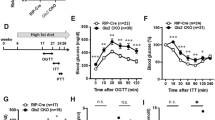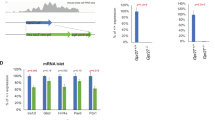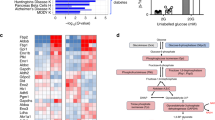Abstract
Glut-2 is a low-affinity transporter present in the plasma membrane of pancreatic (β-cells, hepatocytes and intestine and kidney absorptive epithelial cells of mice1. In β-cells, Glut-2 has been proposed to be active in the control of glucose-stimulated insulin secretion (GSIS; ref. 2), and its expression is strongly reduced in glucose-unresponsive islets from different animal models of diabetes2–4. However, recent investigations have yielded conflicting data on the possible role of Glut-2 in GSIS. Whereas some reports have supported a specific role for Glut-2 (refs 5,6), others have suggested that GSIS could proceed normally even in the presence of low7 or almost undetectable8 levels of this transporter. Here we show that homozygous, but not heterozygous, mice deficient in Glut-2 are hyperglycaemic and relatively hypo-insulinaemic and have elevated plasma levels of glucagon, free fatty acids and β-hydroxybutyrate. In vivo, their glucose tolerance is abnormal. In vitro, (β-cells display loss of control of insulin gene expression by glucose and impaired GSIS with a loss of first phase but preserved second phase of secretion, while the secretory response to non-glucidic nutrients or to D-glyceraldehyde is normal. This is accompanied by alterations in the postnatal development of pancreatic islets, evidenced by an inversion of the α- to (β-cell ratio. Glut-2 is thus required to maintain normal glucose homeostasis and normal function and development of the endocrine pancreas. Its absence leads to symptoms characteristic of non-insulin-dependent diabetes mellitus.
This is a preview of subscription content, access via your institution
Access options
Subscribe to this journal
Receive 12 print issues and online access
$209.00 per year
only $17.42 per issue
Buy this article
- Purchase on Springer Link
- Instant access to full article PDF
Prices may be subject to local taxes which are calculated during checkout
Similar content being viewed by others
References
Thorens, B. Molecular and cellular physiology of GLUT2, a high-Km facilitated diffusion glucose transporter. Int. Rev. Cytol. 137A, 209–238 (1992).
Unger, R.H. Diabetic hyperglycemia: link to impaired glucose transport in pancreatic β cells. Science 251, 1200–1205 (1991).
Thorens, B., Wu, Y.-J., Leahy, J.L. & Weir, G.C. The loss of GLUT2 expression by glucose-unresponsive p cells of db/db mice Is reversible and is induced by the diabetic environment. J. Clin. Invest. 90, 77–85 (1992).
Thorens, B., Weir, G.C., Leahy, J.L., Lodish, H.F. & Bonner-Weir, S. Reduced expression of the liver/beta-cell glucose transporter isoform in glucose-insensitive pancreatic beta cells of diabetic rats. Proc. Natl Acad. Sci. USA 87, 6492–6406 (1990).
Valera, A. et al. Expression of GLUT-2 antisense RNA in β cells of transgenic mice leads to diabetes. J. Biol. Chem. 269, 28543–28546 (1994).
Hughes, S.D., Quadde, C., Johnson, J.H., Ferber, S & Newgard, C.B. Transfection of AtT-20ins cells with GLUT-2 but not GLUT-1 confers glucose-stimulated insulin secretion: relationship to glucose metabolism. J. Biol. Chem. 268, 15205–15212 (1993).
Tal, M. et al. [Val12]Hras downregulates GLUT2 in p cells of transgenic mice without affecting glucose homeostasis. Proc. Natl Acad. Sci. USA 89, 5744–5748 (1992).
De Vos, A. et al. Human and rat beta cells differ in glucose transporter but not in glucokinase gene expression. J. Clin. Invest, 96, 2489–2495 (1995).
Ma, Y.-H., Wang, J., Rodd, G.G., Bolaffi, J.L., tNlrodsky, G.M. Differences in insulin secretion between the rat and mouse: role of cAMP. Eur. J. Endocrinol. 132, 370–376 (1995).
Philippe, J., Pacheco, I. & Meda, P. Insulin gene transcription is decreased rapidly by lowering glucose concentrations in rat islet cells. Diabetes 43, 523–528 (1994).
German, M.S. & Wang, J. The insulin gene contains multiple transcriptional elements that respond to glucose. Mol. Cell. Biol. 14, 4067–4075 (1994).
Docherty, K. & Clark, A.R. Nutrient regulation of insulin gene expression. FASEBJ. 8, 20–27 (1994).
Weibel, E.R. Practical methods for biological morphometry. in Stereological Methods, Vol. I (ed. Weibel, E.R.) 101–161 (Academic, London, 1979).
Matschinsky, P.M. A lesson in metabolic regulation inspired by the glucokinase sensor paradigm. Diabetes 45, 223–241 (1996).
Leahy, J.L., Bonner-Weir, S. & Weir, G.C. Beta-cell dysfunction induced by chronic hyperglycemia. Diabetes Care 15, 442–455 (1992).
Zhou, Y.-P., Ostenson, C.-G., Ling, Z.-C. & Grill, V. Deficiency of pyruvate dehydrogenase activity in pancreatic islets of diabetic GK rats. Endocrinology 136, 3546–1551 (1995).
Giroix, M.-H. et al. Impairment of glycerol phosphate shuttle in islets from rats with diabetes induced by neonatal streptozocin. Diabetes 40, 227–232 (1991).
Pang, K., Mukonoweshuro, C. & Wong, G.C. Beta cells arise from glucose transporter type 2 (Glut2)-expressing epithelial cells of the developing rat pancreas. Proc. Natl. Acad. Sci. USA 91, 9559–9563 (1994).
Offield, M.F. . et al. PDX-1 is required for pancreatic outgrowth and differentiation of the rostral duodenum. Development 122, 983–995 (1996).
Hole, R.L., Pian-Smith, M.C.M. & Sharp, G.W.G. Development of the biphasic response to glucose in fetal and neonatal rat pancreas. Am. J. Physiol. 254, E167–E174 (1988).
Rhoten, W.B. Insulin secretory dynamics during development of the rat pancreas. Am. J. Physiol. 239, E57–E63 (1980).
Kervran, A. & Randon, J. Development of insulin release by fetal rat pancreas in vitro: effects of glucose, amino acids, and theophylline. Diabetes 29, 673–678 (1980).
Swenne, I. Glucose-stimulated DNA replication of the pancreatic islets during the development of the rat fetus: effects of nutrients, growth hormone, and triiodothyronine. Diabetes 34, 803–807 (1985).
Rahier, J., Goebbels, R.M. & Henquin, J.C. Cellular composition of the human diabetic pancreas. Diabetologia 24, 366–371 (1983).
Liang, H. & Gaber, R.F. A novel signal transduction pathway in Saccharomyces cerevisiae defined by snf3-regulated expression of HXT6. Mol. Biol. Cell 7, 1953–1966 (1996).
Ozcan, S., Dover, J., Rosenwald, A.G., Wolfl, S. & Johnston, M. Two glucose transporters in Saccharomyces cerevisiae are glucose sensors that generate a signal for induction of gene expression. Proc. Natl. Acad. Sci. USA 93, 12428–12432 (1996).
Selfridge, J., Pow, A.M., McWhir, J., Magin, T.M. & Melton, D.W. Gene targeting using a mouse HPRT minigene/HPRT-deficient embryonic stem cell system: inactivation of the mouse ERCC-1 gene. Somatic Cell Mol. Genet. 18, 325–336 (1992).
Chomczynski, P. & Sacchi, N. Single-step method of RNA isolation by acid guanidinium thiocyanate-phenol-chloroform extraction. Anal. Biochem. 162, 156–159 (1987).
Suzue, K., Lodish, H.F. & Thorens, B. Sequence of the mouse liver glucose transporter. Nucleic Acids Res. 17, 10099 (1989).
Hopcroft, D.W., Mason, D.R. & Scott, R.S. Standardization of insulin secretion from pancretic islets: validation of a DNA assay. Horm. Metab. Res. 17, 559–561 (1985).
Author information
Authors and Affiliations
Corresponding author
Rights and permissions
About this article
Cite this article
Guillam, MT., Hümmler, E., Schaerer, E. et al. Early diabetes and abnormal postnatal pancreatic islet development in mice lacking Glut-2. Nat Genet 17, 327–330 (1997). https://doi.org/10.1038/ng1197-327
Received:
Accepted:
Issue Date:
DOI: https://doi.org/10.1038/ng1197-327
This article is cited by
-
A large-scale functional analysis of genes expressed differentially in insulin secreting MIN6 sublines with high versus mildly reduced glucose-responsiveness
Scientific Reports (2023)
-
The role of GLUT2 in glucose metabolism in multiple organs and tissues
Molecular Biology Reports (2023)
-
Loss of function of renal Glut2 reverses hyperglycaemia and normalises body weight in mouse models of diabetes and obesity
Diabetologia (2022)
-
Epigenetics: key to improve delayed wound healing in type 2 diabetes
Molecular and Cellular Biochemistry (2022)
-
Pan-AMPK activator O304 prevents gene expression changes and remobilisation of histone marks in islets of diet-induced obese mice
Scientific Reports (2021)



